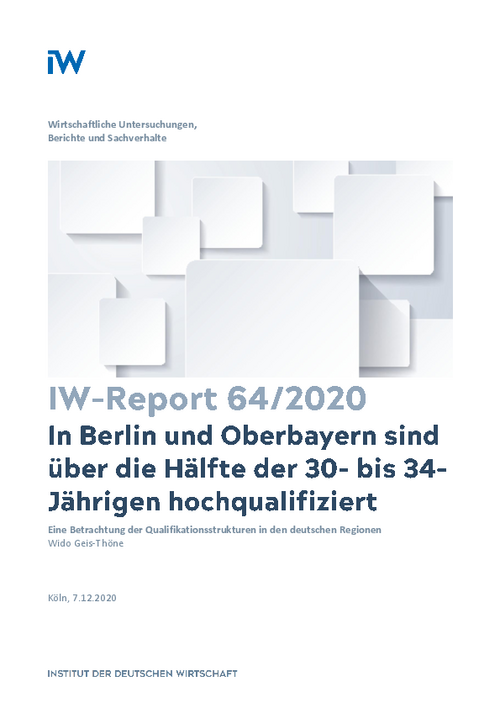The qualification structures of the population vary greatly in the German (NUTS2) regions. While 42.5 percent of 25-64-year olds in Berlin and 40.5 percent in Upper Bavaria are highly qualified, the corresponding percentages in Lower Bavaria and the Weser-Ems region are only 22.8 percent each.

In Berlin and Upper Bavaria, over Half of the 30 to 34-Year-Olds are Highly Qualified: An Analysis of the Qualification Structures in the German Regions
IW-Report

The qualification structures of the population vary greatly in the German (NUTS2) regions. While 42.5 percent of 25-64-year olds in Berlin and 40.5 percent in Upper Bavaria are highly qualified, the corresponding percentages in Lower Bavaria and the Weser-Ems region are only 22.8 percent each.
Looking only at the 30 to 34-year-olds, the range is between 51.3 percent in Berlin and 50.8 percent in Upper Bavaria on the one hand and 21.1 percent in Brandenburg and 21.9 percent in Saxony-Anhalt on the other hand even higher. The proportions of low-skilled workers among 25 to 64-year-olds in Bremen at 19.7 percent and the administrative districts of Düsseldorf at 18.4 percent and Arnsberg at 18.3 percent, each of which covers large parts of the Ruhr area, are also around four times higher than in Thuringia and the Dresden region at 4.8 percent each. Since the level of education of the population is of great importance for the growth potential of the economy and influences local social structures, the development prospects for the regions are very different. This can hardly be changed in the foreseeable future, since improvements in the education system only have an effect on the qualification structures in the regions with a long time lag and, interregional migration movements, which are also relevant for these regions, can only be changed more fundamentally in the long term by the establishment of universities and scientific institutions and similar measures. It should therefore be examined at which points qualification structures give rise to different needs and opportunities for action by the municipalities and other regional players, and where necessary, follow-up action should be taken.

Wido Geis-Thöne: In Berlin und Oberbayern sind über die Hälfte der 30- bis 34-Jährigen hochqualifiziert – Eine Betrachtung der Qualifikationsstrukturen in den deutschen Regionen
IW-Report

More on the topic

Securing skilled workers through immigration to universities
Against the backdrop of demographic change, Germany is increasingly dependent on skilled labour from abroad to secure growth and prosperity.
IW
Pharmaceutical industry: Increasing pressure on the labor market
The shortage of skilled workers poses significant challenges for pharmaceutical companies in Germany and is expected to become increasingly problematic in the context of demographic changes. Concerning Germany's positioning in the international competition ...
IW